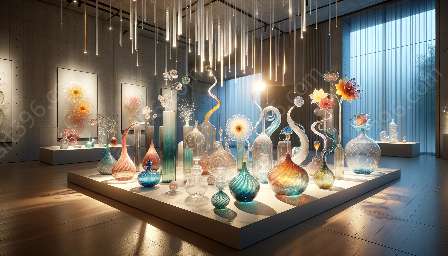Glass art is a craft that demands precision, creativity, and a deep understanding of the materials and tools employed to create captivating pieces. From the raw materials used to the specialized tools that shape and manipulate them, there is a rich and diverse array of elements that contribute to the beauty and allure of glass art. In this guide, we'll delve into the world of tools and materials in glass art, exploring their significance in the realm of visual art and design.
The Significance of Tools and Materials in Glass Art
Throughout history, glass art has held a revered place in the world of visual art and design. The use of specialized tools and a wide variety of materials has allowed artists to push the boundaries of creativity and develop their unique styles. Understanding the significance of these tools and materials is essential for anyone looking to explore or appreciate the art of working with glass.
The Raw Materials
While the focus of glass art is often on the finished product, the raw materials used in the process play a crucial role in shaping the final outcome. Silica sand, soda ash, and limestone are the three primary components used to create glass. These materials undergo a melting process to form molten glass, which can then be shaped and crafted into exquisite works of art.
Colorants and additives are also incorporated to achieve a wide spectrum of hues and effects. These additives can include metal oxides, sulfides, and other compounds, each contributing to the visual and textural properties of the glass. Understanding the characteristics of these raw materials allows artists to manipulate and control the expressive qualities of the glass medium.
Tools of the Trade
The tools utilized in glass art are as diverse as the medium itself. From the precision of glassblowing tools to the intricacies of cutting and engraving implements, each tool serves a specific purpose in the creation of glass art. Some fundamental tools include blowpipes, jacks, shears, punties, and marvers for shaping and manipulating molten glass, while diamond saws, drills, and engraving wheels are used for cold working techniques.
Furthermore, modern technologies have introduced new methods and tools, such as kilns, torches, and specialized molds, expanding the possibilities for creativity and innovation in glass art. Whether the objective is to create delicate filigree work or large-scale sculptural pieces, the right tools are crucial for achieving the desired artistic vision.
Applications in Visual Art and Design
Glass art extends its influence beyond the realm of traditional art forms, permeating into the world of visual art and design. The versatility of glass as a material allows for a wide range of applications, from intricate stained glass windows to contemporary glass installations and functional design pieces. The interplay of light and color in glass art captivates viewers, making it a sought-after medium for both artistic and architectural endeavors.
Artists and designers continue to push the boundaries of what is possible with glass, exploring new techniques and combining it with other materials to create stunning compositions that challenge conventional perceptions of art and design. The fusion of traditional craftsmanship with modern technologies has opened up avenues for experimentation, resulting in innovative forms of expression that resonate with contemporary audiences.
Emerging Trends and Innovations
As the field of glass art evolves, new trends and innovations continue to emerge, shaping the future of visual art and design. The advent of digital fabrication technologies, such as 3D printing and CNC milling, has revolutionized the way artists and designers approach the creation of glass-based works. These advancements offer new possibilities for intricate detailing and precision in manipulating glass, expanding the horizons of artistic exploration.
Furthermore, the sustainable and eco-friendly aspects of glass as a material have garnered increased attention, leading to the development of environmentally conscious practices in glass art and design. Artists and artisans are increasingly exploring recycling and upcycling techniques, as well as incorporating sustainable glass production methods, aligning their practices with the growing emphasis on environmental stewardship in the art and design communities.
The Intersection of Tradition and Innovation
At the intersection of tradition and innovation, glass art continues to captivate audiences with its timeless beauty and contemporary relevance. The centuries-old techniques of glassblowing and glass sculpting coexist alongside cutting-edge technologies, fostering a dynamic and ever-evolving landscape of creativity. This harmonious blend of tradition and innovation underscores the enduring appeal of glass art in the context of visual art and design.
By embracing both the time-honored practices and the latest advancements, artists and designers are able to push the boundaries of what is possible with glass, breathing new life into this age-old art form. This fusion of tradition and innovation ensures that glass art remains a vibrant and vital component of the visual art and design landscape, captivating audiences with its timeless allure and contemporary relevance.

